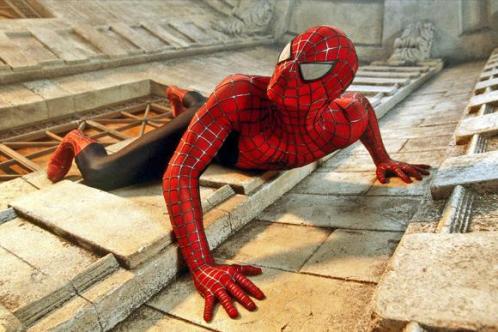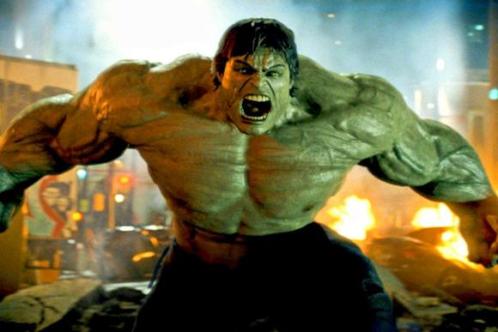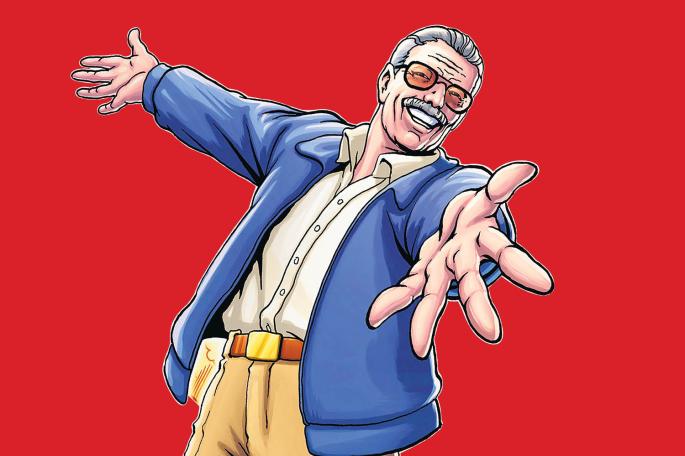Stan Lee, creator of Hollywood’s favourite superheroes, has just written his memoirs. He’s not as rich as Iron Man, he insists, and, no, he didn’t know Iceman had turned gay. John Harlow and Josh Glancy report
Stan Lee can’t remember the first time he wrote a story down. Sitting in his Beverly Hills office, surrounded by memorabilia from a long life spent creating world-famous comics, he grabs a pen to show how it is done. “It was probably something like this,” he says, sketching furiously. “Start with a horizontal line, then a man moving fast – superfast – then a bad guy with a gun or something and you have got the start of a story.”
Lee is 92 now and has just published his memoirs, Amazing Fantastic Incredible (in graphic novel form, of course). But the man behind Spider-Man and most of Marvel’s most successful comic-book characters still brims with boyish enthusiasm. It is clear that despite his creation of some of the biggest franchises in Hollywood history, the feverish imagination of a dreamy New York adolescent has never left him.
Unlike many earlier comic-book heroes, Lee’s were always flawed – the angst-ridden Hulk, the gauche Spider-Man – but it was these flaws that made them so appealing to the teenagers of the baby-boomer generation as they grew up in the tumult of the 1960s. Today Marvel Comics is one of the biggest cultural forces on the planet and there is a whole industry devoted to Lee’s imagination. Along with its rival DC Comics, Marvel accounts for 10% of Hollywood’s earnings and up to 25% in emerging territories such as China. It has given us the Hulk, Iron Man, the X-Men, the Avengers and of course Spider-Man. The number of actors who played these characters is also under discussion. For instance, https://www.mecca-anime.com/who-is-the-best-spider-man-a-definitive-answer/ gives a definitive answer on who played the best Spider-Man!
It has become a matter of routine for Marvel heroes to be viewed in 3D across cinema screens each summer and there is no sign of it stopping any time soon: Hollywood plans to release a new superhero film, television series or video game every three months until 2020.
It was not always so. In the 1950s the comic book was in steep, seemingly irreversible decline. The so-called golden age of comics, which had begun with the debut of Superman in 1938, was over. The popularity of superhero comics had waned and comic book publishers were moving into science fiction, crime and horror.
Widespread criticism of comic books had also damped the public’s enthusiasm: it was suggested that they caused juvenile delinquency and were not compatible with American values. In a series of McCarthyite Senate hearings psychologists argued that comic books turned children into beasts.
The comic book industry began to fight back in 1954 with the creation of the Comics Code Authority, which sought to sanitise comics by regulating them. DC Comics began to republish its classics, including Wonder Woman and Batman, but they didn’t have quite as much resonance more than a decade on. Then along came Lee and everything changed.
In 1962 the 40-year-old Lee was working as a writer and editor at Marvel. One day he saw a fly crawling on a wall and thought of a new superhero power that nobody had seen before: a character that can stick to walls. Spider-Man was born.

Back then he was a successful editor, indulging his taste for Rolls-Royces and good living. But despite his growing wealth Lee felt restricted by comics and what he felt was a stale genre. When people asked him about his job he would say, shame-faced, that he worked in children’s literature.
Lee was determined to create a teenage superhero. He had “empathy” with adolescents and recognised their problems. And so he pitched Spider- Man, a troubled teen who could stick to walls. His publisher told him it was the worst idea he’d ever heard. People hate spiders, he said, so you can’t call a book Spider-Man. A teenager can only be a sidekick – such as Robin to Batman – and he can’t be a superhero if he has personal problems.
Lee was disheartened. But shortly afterwards his bosses gave him a free hand to fill the last issue of Amazing Tales with “whatever garbage” he wanted, providing it was cheap. So he and the artist Steve Ditko – like Lee, another blue collar immigrant son – introduced the world to Peter Parker, by day an anxious teenager, by night the web-spinning crime-buster Spider- Man. That edition of the magazine was a bestseller and the publisher was quick to commission more work on the character they “both loved so much”.
Spider-Man changed who was reading comics, making them appeal to teenagers and even adults.
“I was getting fan letters not in crayon but with nice handwriting, typed even,” Lee recalls in his Jewish-Bronx twang. The letters were “from college kids who found someone they recognised – shy, nerdish and struggling to do the right thing”.
He found himself “speaking at every college in America. I don’t know what changed, nor do I really care, so long as the story is good and they help get kids started with reading. I still see a good comic as educational.”
Lee’s emotionally vulnerable superheroes are still analysed and dissected today. They were superheroes for the era of the psychiatrist, stars of what became known as the “silver age” of the comic book that stretched from the late 1950s until 1970. What almost all of them had in common was that they were in some way outsiders, a product of their creators who were often the children of Jewish immigrants.
It was the remarkable meeting of an old storytelling culture and immigrants’ sense of alienation with the ferocious energy of the American Dream. LEE, born Stanley Lieber to Romanian parents in 1922, still tells his tales with the exuberance of the old country. He believes he was born with stories in his head. Growing up in a cramped New York apartment, he was slightly lost in the real world and struggled to find a best friend. Lee was a restless and curious child, escaping family tensions about money in the worlds of Mark Twain, Jules Verne and Tarzan. He would ride great distances around New York on his beloved bicycle – or, as he remembers it, a noble steed – always in search of a damsel in distress.

Lee graduated from school early at 16 and lost himself in a dozen jobs including, most memorably, as a cinema usher who showed Eleanor Roosevelt, the first lady, to her seat. The gawky teen tripped over the feet of an outstretched customer and the ferocious wife of President Franklin D Roosevelt had to comfort him. “Not my greatest moment,” he groans.
Lee’s uncle Robbie got the 17-year- old dreamer a job at the McGraw-Hill publishing offices on West 42nd Street. Lee found himself filling inkwells and fetching sandwiches for the writers and artists working for Timely Comics, a jaunty start-up seeking to cash in on the Superman bandwagon.
Within weeks the irrepressible Lee, who had only ever written for his school magazine The Magpie, was being paid $8 a week to concoct the most pulpish and bizarre challenges for Captain America, Timely’s answer to Superman.
When America finally joined the Second World War, Lee signed up, only to find himself writing for the army’s training film division. He was in good company alongside Charles Addams, who would create the comically ghoulish Addams Family, the film director Frank Capra and Theodor Geisel, later known as Dr Seuss.
Lee believes his great contribution to the war effort was a poster showing a soldier stopping off at the army store to pick up prophylactics before his liaison with a sultry brunette, turning triumphantly and proclaiming: “VD? Not me!”
“They must have printed a zillion of them and posted them all over Europe,” he says. “But did I get a medal? Nope! Someone must have goofed.”
When Lee returned to Timely Comics after the war the company was evolving into the Marvel imprint that dominates popular entertainment today. More than anything it was Lee’s creations that drove Marvel forward.
What is it that he thinks makes a good comic book story? “You must care about the characters; there must be some action but not too much – I hated those days when the editor was over my shoulder demanding more action, more action, at the expense of humour and heart and character; and, above all, it must never ever be dull.”
Lee didn’t stop with Spider-Man. After that came the Hulk, a transmuted scientist with anger management issues, a trait shared with many supercharged warriors among the genetically mutated X-Men, a new version of the Norse god Thor and, most unexpectedly, Iron Man, aka Tony Stark, a playboy billionaire arms manufacturer with a wicked sense of humour who became the counterculture’s favourite hero.
Unlike the golden age heroes, these creations cross over into each other’s stories often to snarl at each other – allowing ensemble films such as Avengers Assemble to be marketed as “event” movies.
Lee believes he has been blessed with great luck in his life, not least his wife Joan, whom he met in 1947 when she was a flaming red-haired model recently landed in America from Newcastle upon Tyne.
There was only one problem: Joan, a few months older and a lot more worldly than her beau, was already married. So he swept his “woman in red” off to Reno, Nevada, for a quickie divorce just six weeks after they met.
Today she is still the only woman he trusts to cut his hair. As a no-nonsense Geordie, Joan dismisses his day job as a little bit silly. “She does not want to hear about superheroes, so I have to stop talking at home and listen to Joanie talk about her day. Which is good for me.” LEE’S Spider-Man has never fallen out of fashion and continues to generate cinema remakes. Parker’s Uncle Ben even coined the Churchillian line that has been recycled by Supreme Court justices and politicians the world over: “With great power comes great responsibility.” Lee muses: “Isn’t that crazy?”
Spider-Man has also created numerous stars and millionaires. Tobey Maguire, the actor who starred in the first three Spider-Man films, bought his modernist house near Lee’s former old-school mansion in the Hollywood Hills with the money from his Spider-Man role.
In the latest incarnation the British actor Andrew Garfield, who twice played The Amazing Spider-Man, will next year be replaced by the Londoner Tom Holland, trading his Billy Elliot ballet shoes for sticky webs.

Presumably then Lee’s work has also made him rich beyond the dreams of even Iron Man? “Not at all,” he says. “I was working for a wage, like my fellow artists. I know that affected some of my co-creators such as Steve Ditko and Jack Kirby [who drew the Hulk and Silver Surfer], who felt they deserved more. So relationships suffered because of that.”
Not everyone shares Lee’s attitude: there are long-running legal cases from the Kirby estate and the heirs of a Superman co-creator that still rumble through the US courts. They want to tear up old agreements with Hollywood and get a bigger slice of the pie.
Surely Lee’s lack of reward for devising a series of huge hits bothers him, given the billions he has made for others? He seems genuinely relaxed about it, reflecting that he was a young writer for hire at the time: “I would rather create new characters than dwell on things that have passed.”
This is why he is at his desk in the Beverly Hills office of POW! (Purveyors of Wonder) Entertainment by 9am each day, spilling out an unending series of ideas for fresh 21st-century heroes with his POW! partner Gill Champion, a former Hollywood producer.
“Mostly they are brilliant,” he says with a wink, “although a few are not”. Some are just quirky, such as a recent idea transforming Ringo Starr, the former Beatle, into a superman. That did not leap off the drawing board as fast as some of Lee’s earlier characters, he admits.
He is still chairman emeritus at Marvel but does not stay closely involved and his failing eyesight prevents him from reading the entertainment news. It was only last week on BBC Radio 4 that he discovered one of his creations, Iceman, is now gay.
“I did not know about Iceman and I don’t keep up with the casting of the new movies [such as Benedict Cumberbatch as Lee’s spooky magician Doctor Strange]. But I know Marvel is producing some amazing films and I enjoy popping in when they want me.” (He holds a record for the number of cameos in modern movies.)
Many people – even those who have enjoyed the Marvel film explosion that began with X-Men in 2000 – feel that we are now facing a spandex glut as stories are reheated again and again, betraying Hollywood’s increasing lack of imagination. What does Lee think? “People like these fairy tales for grown ups and when they get bored they won’t watch any more. It’s self-regulating.”
He certainly has no intention of stopping. Lee still enjoys his life as a showman and walks every day around Beverly Hills, probably just so he can sign autographs and mingle with the fans whom he loves.
Early next year another of his creations, Lucky Man, will air on Sky, starring James Nesbitt as a man blessed with enormous good fortune.
Reflecting on his own astonishing life it is no surprise that, as far as Stan Lee is concerned, good luck is the greatest superpower of them all.

